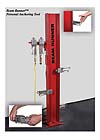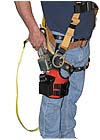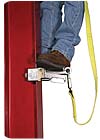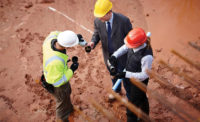
The Beam Runner anchoring device clamps easily onto any angle iron or beam flange capable of supporting 5,000 pounds of impact per attached worker.
[Editor's note: This article concludes a three-part series on anchorage points and personal fall arrest systems.]
In the two previous articles in this series, I discussed terminal impact force (TIF) analysis in selecting a suitable structural point to attach an anchor device. A suitable anchor point is a point capable of withstanding the potential 5,000-pound applied impact force (per attached worker) imposed over any existing uniform and/or concentrated live and dead loads already in play. Now it is time to discuss selection of the appropriate anchorage device, based on the type of work being performed, the number of workers applied to the personal fall arrest system, and the structural parameters of the workplace, as well as the environmental conditions of the site.
ANSI defines an anchorage connector (AC) in Z359.1, "Safety Requirements for Personal Fall Arrest Systems, Subsystems and Components," Section 2.4, as "a component or subsystem with means specifically intended for coupling the PFAS to an anchorage point." It goes on to state, "Anchorage connectors are usually installed (temporarily or permanently) on such anchorages as a beam, girder, column or floor. An anchorage connector (AC) may be moveable or portable, ... provided the necessary precautions and controls have been put into effect to ensure the anchorage connector complies with standard."
These permanent and temporary attachment devices come in as many shapes, sizes, materials, attachments and prices as there are manufacturers in the NYC Blue Book. They may be non-destructive type, such as beam trolleys, beam clamps, column clamps, beam wraps and cross arm straps. They may also require that some modification, sometimes destructive, be made to the structural materials in order to install them, such as through bolts (in shear and tension), welded pad-eyes, constant force post anchors and powder-actuated or epoxy studs. There are devices that require a specific set of installation criteria and others that may be applied to a myriad of locations. There are devices that require extensive site preparation and guarding while others need nothing more than brushing off before installing. But in every case, prior to connection of the device, the competent person should always (1) review the qualified person's TIF analysis of the anchor points; (2) review the manufacturer's instruction for installation and/or operation; and (3) thoroughly inspect the equipment for any damage, defects or deterioration prior to use.
I have made it my personal research project to investigate as many of these devices as possible for the past 10 years. As a result, I have acquired an extensive collection of attachment hardware, from the simple to the complicated, from the cheap to the expensive. But there is one PFAS personal anchorage device I would select above all others for attachment to structural steel components capable of resisting the minimum arresting force. That would be the Beam Runner™.

Weighing just 3.5 pounds, the Beam Runner may be worn easily in a right- or left-handed snap-lock holster fastened to the belt and upper thigh by Velcro adjustable straps.
Enter The Beam Runner
It is a finely crafted, USA-made piece of machined equipment designed to be carried and easily installed as an anchor device by one man with one hand. It is entirely designed and fabricated by Louis Cowin, a master machinist located in Bohemia, N.Y., to solve the difficult anchorage problems faced by many of his friends in the ironworkers' trade. The final result of 10 years of expensive and intensive R&D is a user-friendly, lightweight personal anchor device that may be worn easily in a right- or left-handed snap-lock holster fastened to the belt and upper thigh by Velcro adjustable straps. The price for this technologically advanced, precision-made product has dropped from over $1,000 per unit several years ago to a list price of $875 today.Mr. Cowin has thoroughly researched the moneysaving aspect of his device in the construction and maintenance markets. The initial savings are provided by it's ease of use and versatility in all types of construction. His return on investment (ROI) calculations while using a Beam Runner equal an average savings of two man-hours per 40 hour workweek. The ROI calculator on his Web site (www.beamrunner.com) analyzes a payback period of four to 12 weeks, depending on the tradesman's rate of pay. After a year of use, based on an occupation performed above 6-foot heights, the ROI can range from 560 percent up to an astounding 1,430 percent. This device can not only save lives, it may quickly boost profits.

The top of the handle features a 1-inch by 4-inch platform, which can be used as a step by the operator.
Construction Features
The overall size of the Beam Runner is 11 inches long by 4 inches wide by 1.75 inches thick. It weights just 3.5 pounds. The patented "mechanical force multiplier" designed in the stainless steel trigger grip and release activates two jaws with four 1/16-inch conical teeth, which actually penetrate carbon steel for a tremendous grip capable of resisting a 5,000-pound impact force. These teeth are replaceable by the manufacturer. Several units have gone over a year in perfect shape used by a steel-erector contractor who cycles their position multiple times per hour. There is a low-profile, stainless steel safety plate incorporated inside the bottom grip, which must be depressed in order to engage the handle for operation, thus preventing unintentional release. The jaws in the standard model are adjustable up to 1-inch-thick steel or other metal, seating approximately 1 inch onto the material' s surface. Other models of Beam Runner are in production capable of gripping steel flanges from 1 inch to 2 inches thick and 2 inches to 3 inches thick, such as those found in many large-span bridge beams. The top of the handle is designed with a checkered 1-inch by 4-inch platform, "dimpled" for traction, which can be comfortably and conveniently used as a step by the operator. The slot-welded design of this feature also reinforces the 5/16-inch stainless steel anchorage arm during the terminal impact of an arrested fall, enabling the weld itself to partially release, absorbing vector forces and preventing distortion. The end of the top stainless steel grip handle is formed into a 1.5-inch diameter eyelet suitable for attaching an ANSI-standard safety latch from a synthetic or wire rope lanyard.To use the tool, the worker must squeeze the handles together and hold the handles in position; this retracts the locking piston. Next, the worker places the tool on the flange of the I-beam and turns the large, knurled knob to tighten the tool plate on the flange. Then the worker backs off a half-turn and releases the handles. The tool is self-locking.
By simply releasing the grip handles, the maximum compression force is reapplied, causing the tungsten carbide steel teeth to form a secure, dependable grip. The Beam Runner may be installed horizontally from the flange of a column forming either a step or a PFAS anchor point, or vertically from the bottom flange of a beam as an anchor for PFAS or a vertical fixed or retractable lifeline. The stainless steel ID plate on every unit notes the manufacturer's name and address, the owner's name, date of manufacture, serial number and various U.S. patents. It is also important to note that the rated capacity for the Beam Runner, as with all PFAS equipment, is 310 pounds maximum. The manufacturer recommends destroying the unit should it be involved in any fully arrested fall, which could affect its structural integrity.
This is a highly engineered and precisely constructed personal anchorage device, capable of many trouble-free and dependable service years. Operator training is crucial to any personal fall arrest equipment, and the Beam Runner is no exception. Above and beyond a basic personal fall arrest training program (1926.503(a)), the employer shall train those employees required to use this personal anchoring device in the manufacturer's construction, operation, inspection, and maintenance (lubrication and cleaning) procedures. In general, this will take only several hours, with adequate hands-on practice time before employees are designated authorized in its use. Of course, like any good tool, the more you use it, the simpler the operational features become to the worker.
Productivity and Peace of Mind
Regardless of his tasks, a construction worker wearing one or more Beam Runners is easily able to establish quick and dependable anchor points for whatever personal fall arrest system is being designed or revised. Suddenly a roofer, welder, pipe fitter, millwright or mason is no longer distracted by the often difficult and time-consuming problem of establishing a suitable anchor point. Now he can anchor himself quickly and safely and get back to making a profit without the fear of a fatal fall. When I perform construction fall accident investigations, I typically determine that the system was (1) incapable of changing as the workplace underwent development, or (2) the ability to reinstall fall protection ahead of the personnel required to use it was either neglected or incomplete. The Beam Runner has the unique capability of being easily moved and adaptable to almost any situation on the site.Every time every worker on a jobsite climbs more than 6 feet above a lower level, guardrails, safety nets or personal fall arrest equipment must be implemented by the employer. Installing heavy, clumsy beam and column clamps can be quite a challenge for workers 6 to 15 feet above a lower level. Even nylon anchor straps, beam wraps and cross-arm straps, although lightweight, require two hands to install and connect properly. Whenever and wherever a roofer or other tradesperson can locate a suitable structural feature capable of accepting and supporting a Beam Runner, the problem of anchorage is solved. Perhaps the most economical feature of the device is its simple one-handed operation. With only a moderate squeeze of the handles, the jaws engage, ensuring a 5,000-pound anchorage. Once engaged properly by a trained employee, the Beam Runner is both reliable and profitable, and that's a hard combination to beat.


Report Abusive Comment